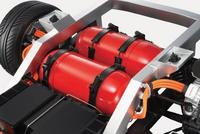Honda to Begin Producing Next Generation FCX Hydrogen Fuel Cell Vehicle
Detroit January 8, 2006; Signaling a rapid advancement in its fuel cell vehicle technology, American Honda Motor Co., Inc., today announced that it will begin production in Japan of its next generation FCX hydrogen powered fuel cell vehicle (FCV) in three to four years. The FCX Concept vehicle, unveiled just four months ago and now on display at the North American International Auto Show, boasts a fuel cell system that delivers more power in less space, in a unique, low-floor fuel cell platform. The premium fuel cell sedan offers the ultimate in clean-running performance, and represents Honda's vision of future mobility in which vehicles are less dependent on fossil fuels and produce no significant emissions.
Honda's FCX Concept defines a new stage in the evolution of fuel cell vehicle technology. The FCX Concept is designed with a low center of gravity and a full-sized cabin, offering the kind of driving pleasure and roomy interior previously unimaginable in a fuel cell vehicle. The FCX Concept is designed with a short front end to make the most of its unique low-floor platform, creating a comfortably large cabin. A tapered cabin profile and accentuated fender flare create an attractively dynamic look. The FCX Concept is an FCX that delivers style and excitement.
Using an innovative approach, the new, high-efficiency, compact V Flow fuel cell platform makes possible the lowest-floor platform in an FCV ever. Oxygen and hydrogen flow from the top to the bottom of the fuel cell stack (vertical gas flow) and the fuel cells are arranged vertically in the center tunnel (vertebral layout) for new, high-efficiency fuel cell packaging (volume efficiency).
Compact enough to fit neatly into the center tunnel but robust enough to put out 100kW of power, Honda's V Flow fuel cell stack offers space efficiency and high-energy output. The key to fuel cell performance is water management; Honda's new system takes full advantage of gravity to efficiently discharge water formed during electricity generation. This improves performance in sub-zero temperatures, further solving the problem of cold-weather startup that has been a key obstacle to the commercialization of FCV's. Now, with the V Flow fuel cell stack Honda has achieved ultra-low-temperature start-up performance on par with that of a gasoline engine. The FCX Concept drive train features three energy-efficient motors- one 80kW in the front and a 25kW space-efficient motor in each rear wheel, leaving ample room for a spacious cabin.
One barrier to FCV commercialization has been the need for high-capacity yet lightweight and compact hydrogen storage. Honda has now developed a new approach to expanding storage capacity, a newly developed hydrogen absorption material in the tank doubles capacity to 5 kg of hydrogen at 5000 PSI, extending cruising range to 350 miles, equivalent to that of a gasoline-engine car.
Approaching the vehicle, the driver is recognized by vehicle sensors and intelligent cameras unlocking the doors. The driving unit also automatically sets the steering wheel, accelerator pedal, and instrument panel to the optimal position for the driver. The instrument panel tilts up and down 45 degrees in response to vehicle speed to give either a sense of security or a relaxed feel. A system installed in the instrument panel senses the driver's line of sight shifting toward menu icons, and operates switches accordingly, allowing the driver hands-free operation of audio, AC and other systems.
As part of its effort to ensure the viability of a hydrogen-based society, Honda is developing the Home Energy Station (HES), a comprehensive system designed to meet residential energy needs by supplying electricity and heat in addition to hydrogen fuel for vehicles. Generating hydrogen from natural gas supplied for residential use, the HES system also offers consumers the convenience of refueling hydrogen-powered fuel cell vehicles at home. The system is equipped with fuel cells that generate and supply electricity to the home, and is configured to recover the heat produced during power generation for domestic water heating. In addition to reducing carbon dioxide emissions by some 40 percent, the HES system is expected to lower the total running cost of household electricity, gas and vehicle fuel by 50 percent.





